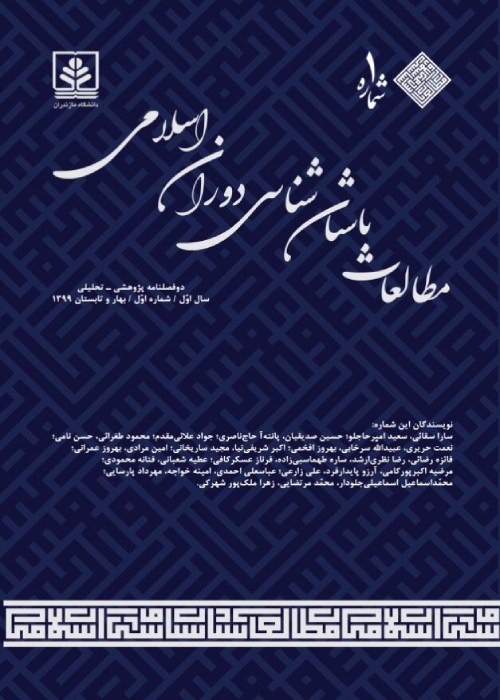A Comparative Study on the Mina'i Motifs within Kashan and Rey Pottery Centers through 6th and 7th Centuries A.H. Based on Metropolitan Museum Samples
Mina'i wares have experienced a noticeable development within sixth and seventh centuries AH. Iranian potters have been using some of pre-Islamic motifs in order to revive their past culture and traditions. Among the most important centers involved in the creation of Mina'i wares are Kashan and Rey, each with their own particular style and pattern. Despite the existence of similarities and differences between the investigated motifs and the degree of using similar themes on Mina'i wares with their production centers and the emphasis made by researchers on this point, kind of scarcity can be seen in this regard. Accordingly, by investigating the motifs, their texture and coloring as well as finding the relationship between Kashan and Rey’s Mina'i wares and their production centers, the researchers attempt to find out the relationship between the motifs on both centers’ Minai wares as well as the relationship between motifs and their own production centers. Similarly, in other words, it was easier to investigate the foreign samples. All the pictures taken from the Metropolitan Museum have acceptable quality and resolution, making it easier for the researcher to compare them. This study used desk study as well as museum study as a research method, and also we made comparisons and analysis for testing our research’s question.
In this study, due to the uniqueness and ease of access to enamelware information which is kept in the Metropolitan Museum, we selected fifteen samples.
Enamel is a complete event and masterful development that was produced in different forms through the sixth and seventh centuries A.H until the early Mongol period. One of the special features of enamel pottery is its beautiful decorations and various motifs that create meaningful images by deriving the previous artistic heritage from the past, such as the Sassanids. These motifs express the beliefs and social life in the Seljuq and Khwarazmshahian periods that tried to keep their original culture alive, which made this type of pottery superior. Enamel pottery was often produced on a large scale in famous pottery workshops, including Kashan and Rey. What is undeniable is the existence of merchants and craftsmen of the cities, who should be considered the main reason for the spread of these vessels. The images on the enamel pottery with its unique characteristics can show the production center of Kashan and Rey. It seems that due to the proximity of Kashan and Rey centers, there is not much difference in the designs of the potteries. One of the characteristics of enamelware in this period is the preservation of patterns in the use of special patterns; the emphasis in the decoration of these works shows that the artist has observed the proportions and compositions between the arrays and the visual elements as well with full knowledge. In the enamel paintings on these centers, the artists have been more successful than any other period in combining plant, animal and human motifs and creating composition as well as balanced structure; each has its own unique features and characteristics. For example, the enamelware of Rey city has been superior to Kashan in terms of using enamel material in different types of products. These very delicate and luxurious subjects are decorated with the story of war and feast, which includes images of princes, men and women, hunting grounds with polytheists, war, feasts, scenes of bravery and heroism. Also, Islamic decorations with beautiful and prolific terracotta, plants, dalber or dotted motifs with colorful dots and stripes in a row of imaginary animals have covered the surface on the pottery. Kashan enamel pottery also has narrative themes and special attention has been paid to Islamic motifs; also, love stories and lyrical themes are noticeable for the first time. The cypress tree, which is a symbol of youth and freedom is sometimes depicted in the role of a tree of life and sometimes it shows rituals with Islamic decorations inside. Foliage hair, lotus and the fish floating in the water are the main elements of Kashan painting style and sometimes like Rey they have motifs of hunting ground, horse, Majlis Tarb and love stories. Faces are depicted in Kashan enamelware like the faces in Persian poems, round with almond eyes, bud lips, long hair around or braided and headband ornaments in great detail, precise and delicate. Faces are simple, careless or faded, and often with short, unadorned hair. It seems that the designs used on enamel pottery can be classified according to the manufacturing centers. One of the suggestions of the authors in the continuation of research is to compare the centers of Kashan and Rey with other major centers of enamel pottery such as Jurjan and Sultanabad.
- حق عضویت دریافتی صرف حمایت از نشریات عضو و نگهداری، تکمیل و توسعه مگیران میشود.
- پرداخت حق اشتراک و دانلود مقالات اجازه بازنشر آن در سایر رسانههای چاپی و دیجیتال را به کاربر نمیدهد.


